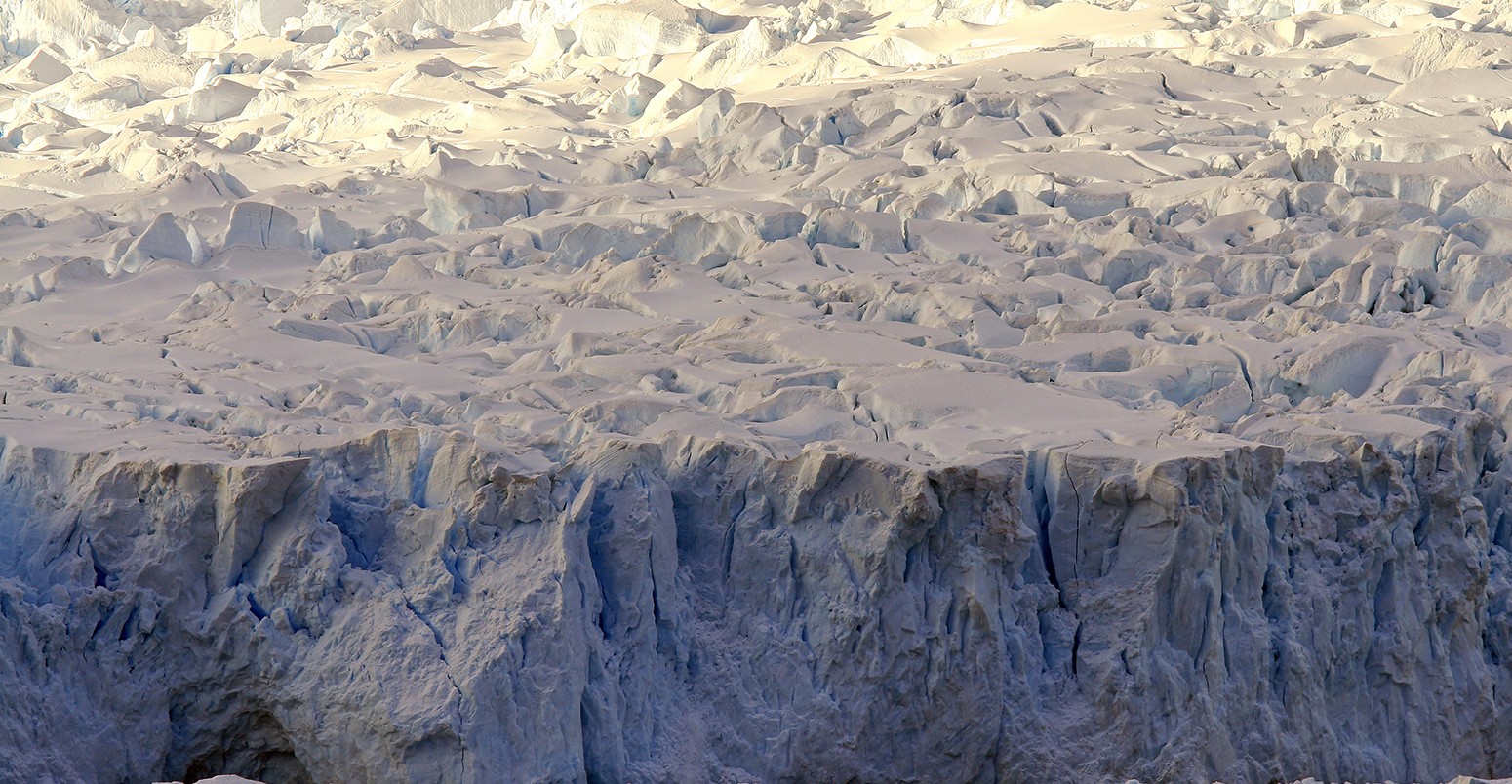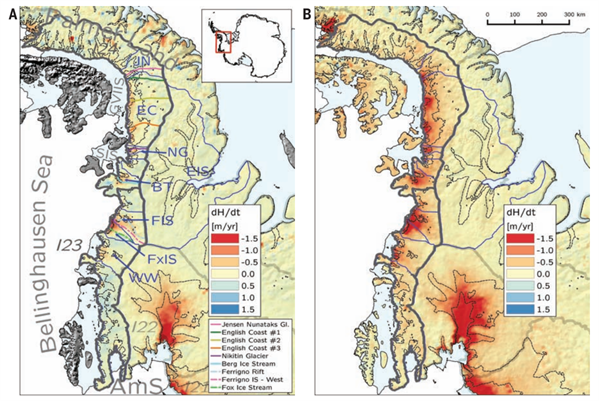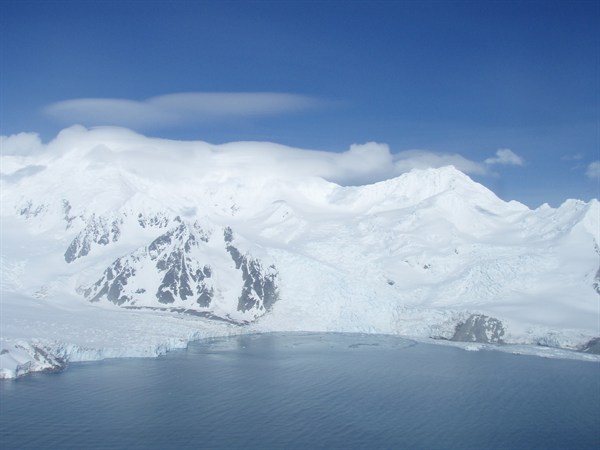Satellites reveal rapid acceleration of Antarctic glacier ice loss
Robert McSweeney
05.21.15Robert McSweeney
21.05.2015 | 7:00pmThinning of glaciers in one of the most vulnerable parts of Antarctica has accelerated at a “remarkable rate” since 2009, a new study finds.
Stable through the 2000s, the glaciers began losing large quantities of ice within just a year or two, the lead author tells Carbon Brief.
The study shows the surprising speed with which Antarctica’s glaciers can react to rising ocean temperatures, and without warning, he says.
Remarkable acceleration
Glaciers are huge rivers of ice that ooze their way over land, powered by gravity and their own sheer weight. They accumulate ice from snowfall and lose it through melting.
In the new study, published today in Science, researchers analysed changes to glaciers on the Southern Antarctic Peninsula in the last decade and a half.
For most of the 2000s, satellite data shows the glaciers lost about as much ice as they gained, meaning they stayed roughly stable. But around 2009 there was “a remarkable rate of acceleration” in ice loss, the study says.
The red and orange areas in the figure below show thinning of glaciers along the Bellinghausen Sea coast. You can see the melting is much more rapid between 2010 and 2014 (right-hand image) than between 2003 and 2009 (left-hand image).
Change in glacier thickness between A) 2003 and 2009 and B) 2010 and 2014 in the Southern Antarctic Peninsula. Oranges and reds show areas of greatest thinning. Source: Wouters et al. ( 2015)
This is a very important finding, says Dr Hilmar Gudmundsson from the British Antarctic Survey, who was not involved in the study:
“What this paper is telling us is there is a sharp increase in mass loss along the Southern Antarctic Peninsula. And that is new. We haven’t really seen this before.”
Warming ocean
The glaciers are being melted from underneath by a warming ocean, lead author Dr Bert Wouters, a research fellow from the University of Bristol, tells Carbon Brief. And stronger wind patterns around Antarctica are dragging more of this warm water towards the glaciers, he says.
Wouters produced an animation to illustrate what’s happening.
Animation of the ice loss of the Southern Antarctic Peninsula. Credit: Bert Wouters
A warming ocean is having a similar effect on glaciers in other parts of the Peninsula as well, Gudmundsson says:
“This fits to a picture which we are seeing, generally speaking, along the Antarctic Peninsula, which is that the ocean is causing an increase in melt and an increase in mass loss.”
The likely causes of these changing wind patterns are the combined impacts of climate change and the hole in the ozone layer above Antarctica, Wouters says.
Distant view of an Antarctic glacier system. Credit: Alba Martin-Español
Ice shelves
So, what caused the sudden acceleration in glacier ice loss around 2009? Thinning ice shelves are a likely candidate, thinks Wouters.
An ice shelf forms when a glacier reaches the coast and flows into the ocean. If the ocean is cold enough, the ice doesn’t melt. Instead, it forms a permanently floating sheet of ice.
The ice shelves in front of the Southern Antarctic Peninsula glaciers have been thinning in recent decades, Wouters says:
“These ice shelves hold back the ice on land, but as they thin, the force they exert on the glaciers weakens. [This] will result in a speed-up of the glaciers, which are now shedding more ice into the ocean.”
Just last week, a separate study found that thinning of the Larsen-C ice shelf on the tip of the Antarctic Peninsula put it at risk of collapse. But an ice shelf doesn’t have to collapse to allow glaciers to flow more quickly, Wouters says. The propping-up effect of the ice shelves can diminish long before they disappear completely.
Floating ice shelf where Antarctic glacier meets the ocean. Credit: Alba Martin-Español
Retreat
The shape of the Southern Antarctic Peninsula makes glaciers particularly vulnerable to the warming ocean, the paper says.
As glaciers flow towards the water, they are typically helped along by gravity as the land slopes down towards the coast. But the Southern Antarctic Peninsula is unusual as the much of the land actually rises towards the coast.
So if a glacier melts, it doesn’t retreat upwards and out of the reach of the warm ocean. Instead, the water follows the retreating glacier, continuing to melt it.
You can see this in the animation below.
Thinning at the front edge of glaciers has more than doubled in recent years, the paper says. And it’s happening 100km further inland, which is another sign of warm ocean water pushing glaciers into retreat.
Sea level rise
Since 2009, glacier melt along the Bellinghausen Sea coast has added 300 trillion litres of water to the ocean, the researchers say. This translates into an increase in global sea levels of about 0.16mm a year, the study says. That’s about 5% of the total contribution from Antarctica as a whole, adds Wouters.
There’s enough ice in the Southern Antarctic Peninsula to raise sea levels by 35cm, Wouters says, but it would likely take centuries for this to happen.
But that doesn’t mean we shouldn’t worry, he says:
“Our study shows that the ice sheet responds very rapidly to changes in its environment and that rapid ice loss can start within a couple of years, without any warning signs beforehand.”
And if this can happen somewhere scientists had previously seen little change, we could begin to see similar acceleration in other regions, Wouters warns.
Main image: A glacier wall.
Wouters, B. et al (2015) Dynamic thinning of glaciers on the Southern Antarctic Peninsula, Science, doi:10.1126/science.aaa5727





